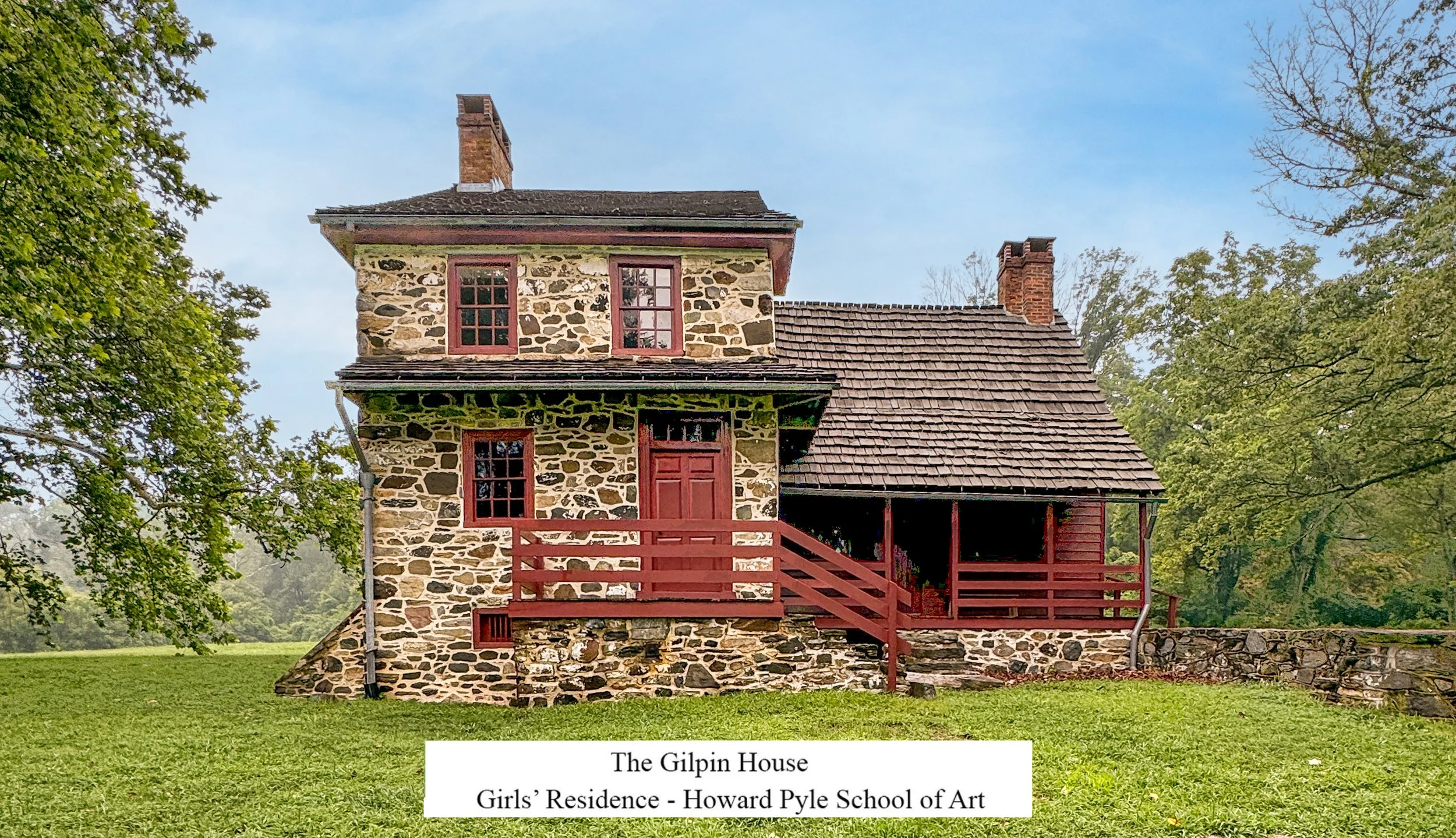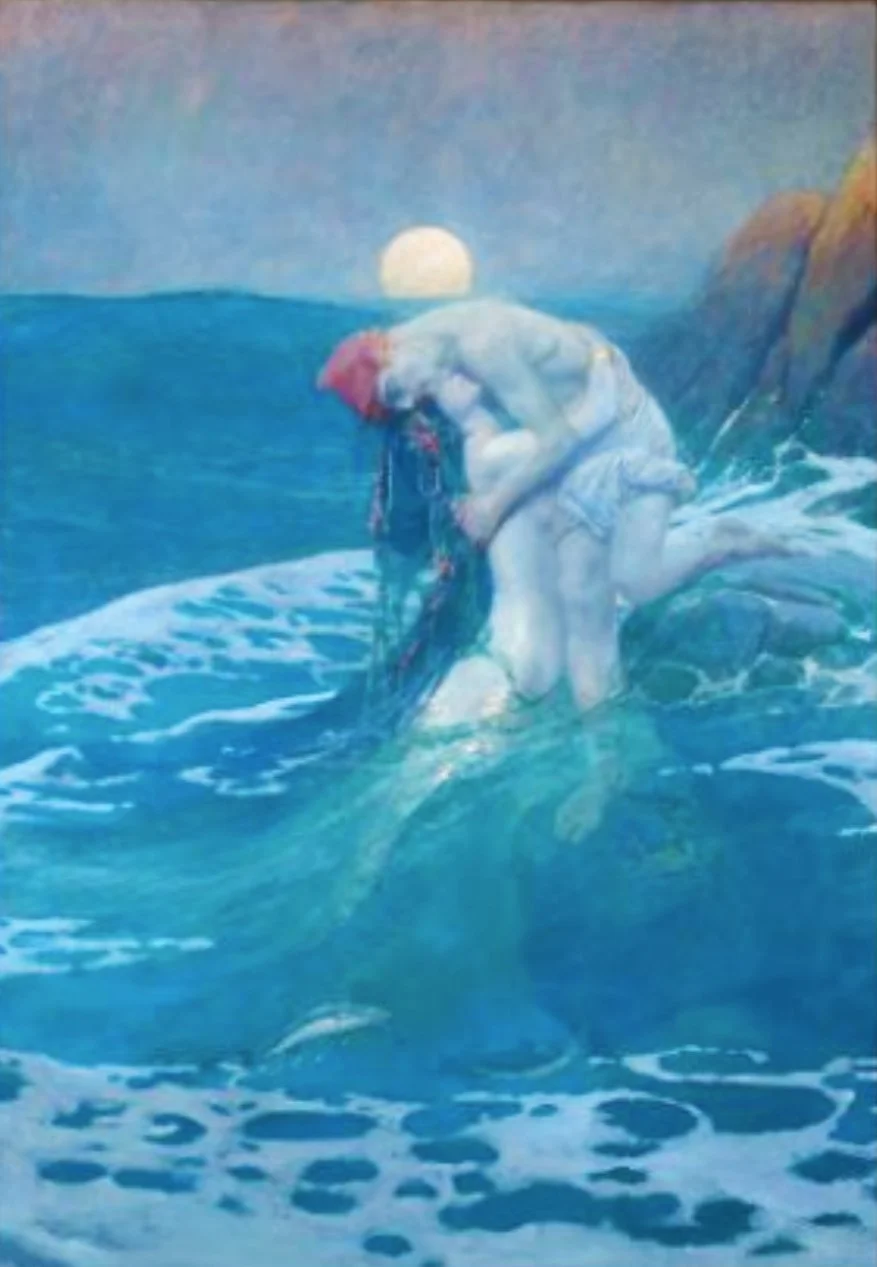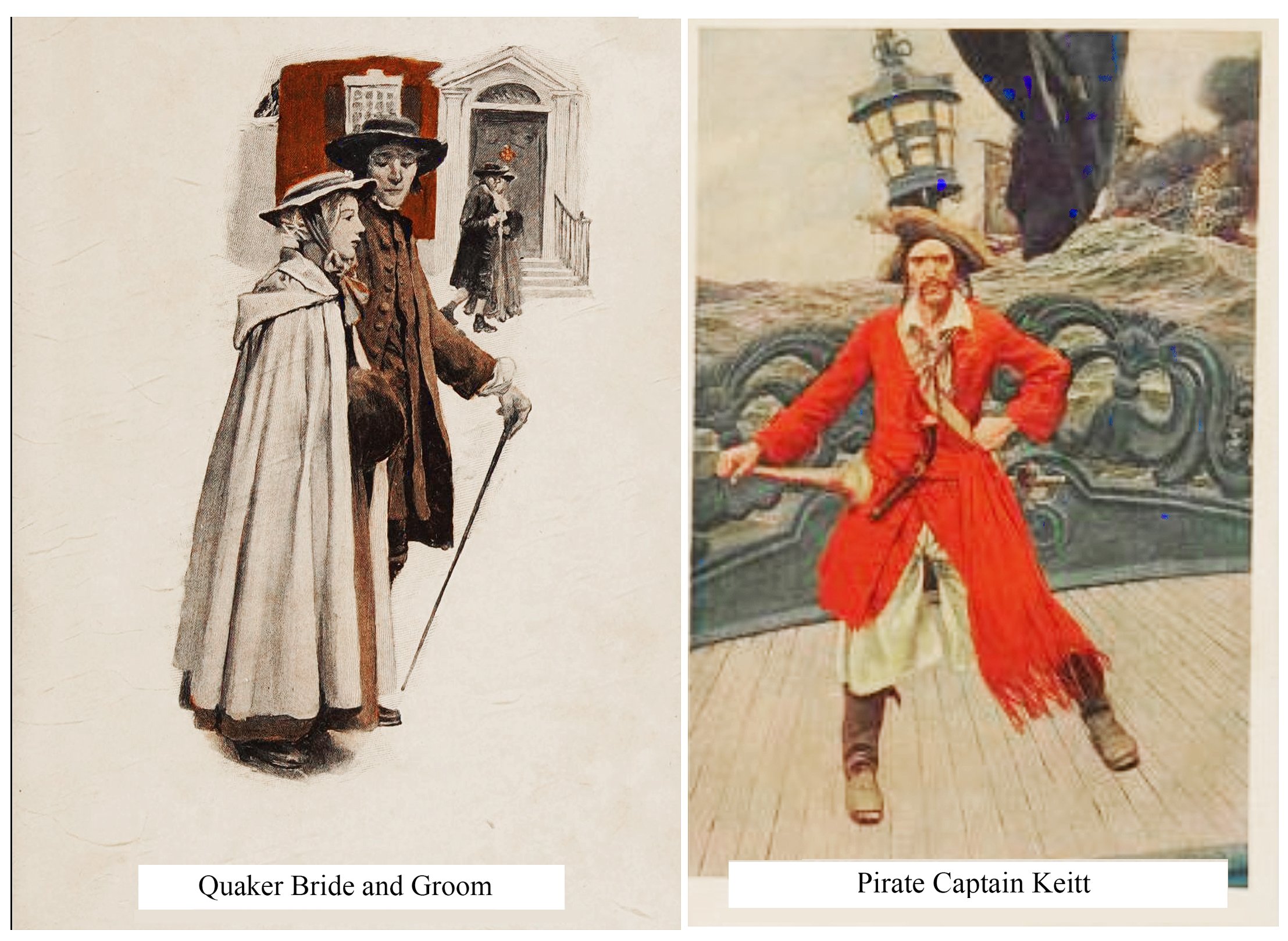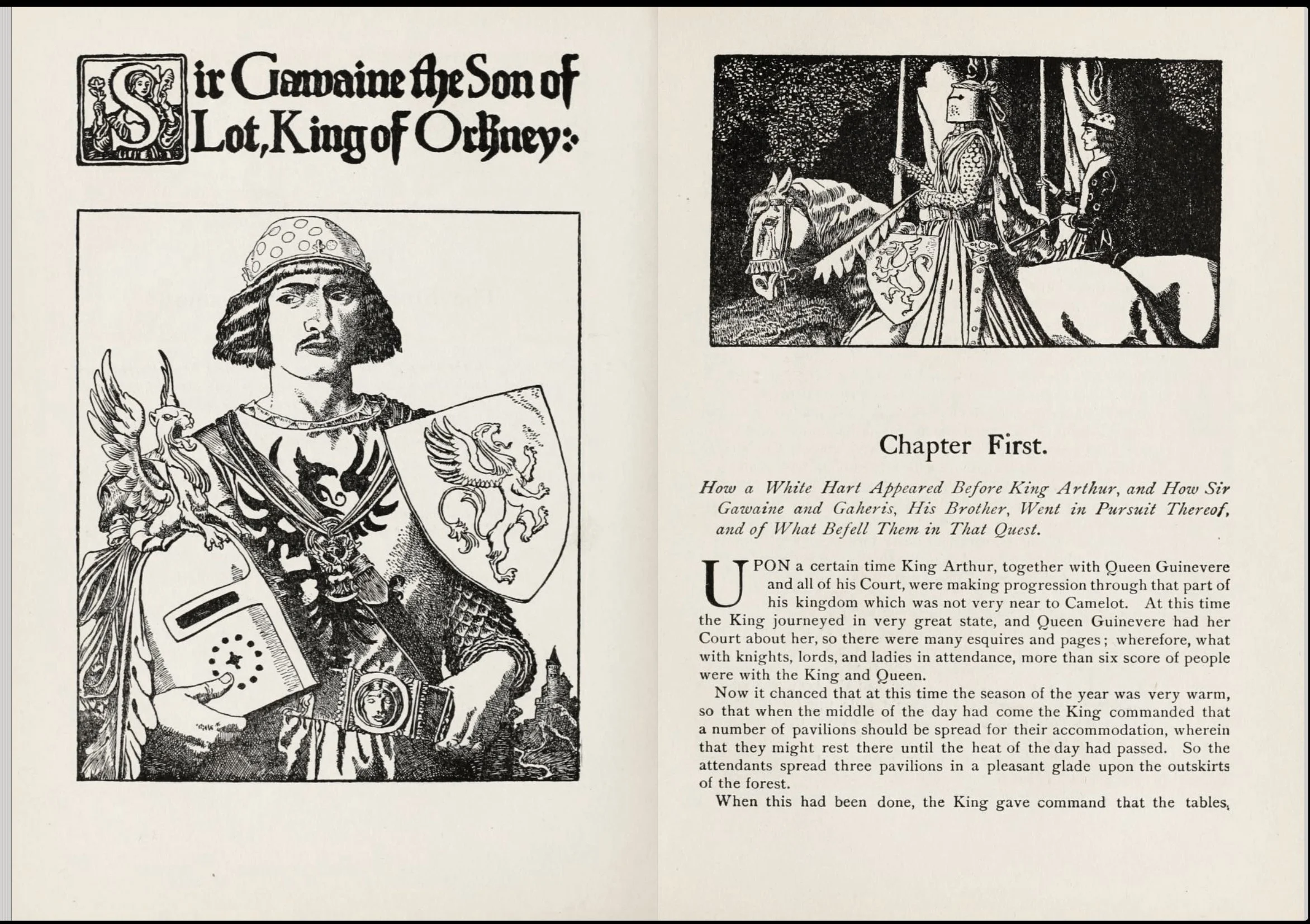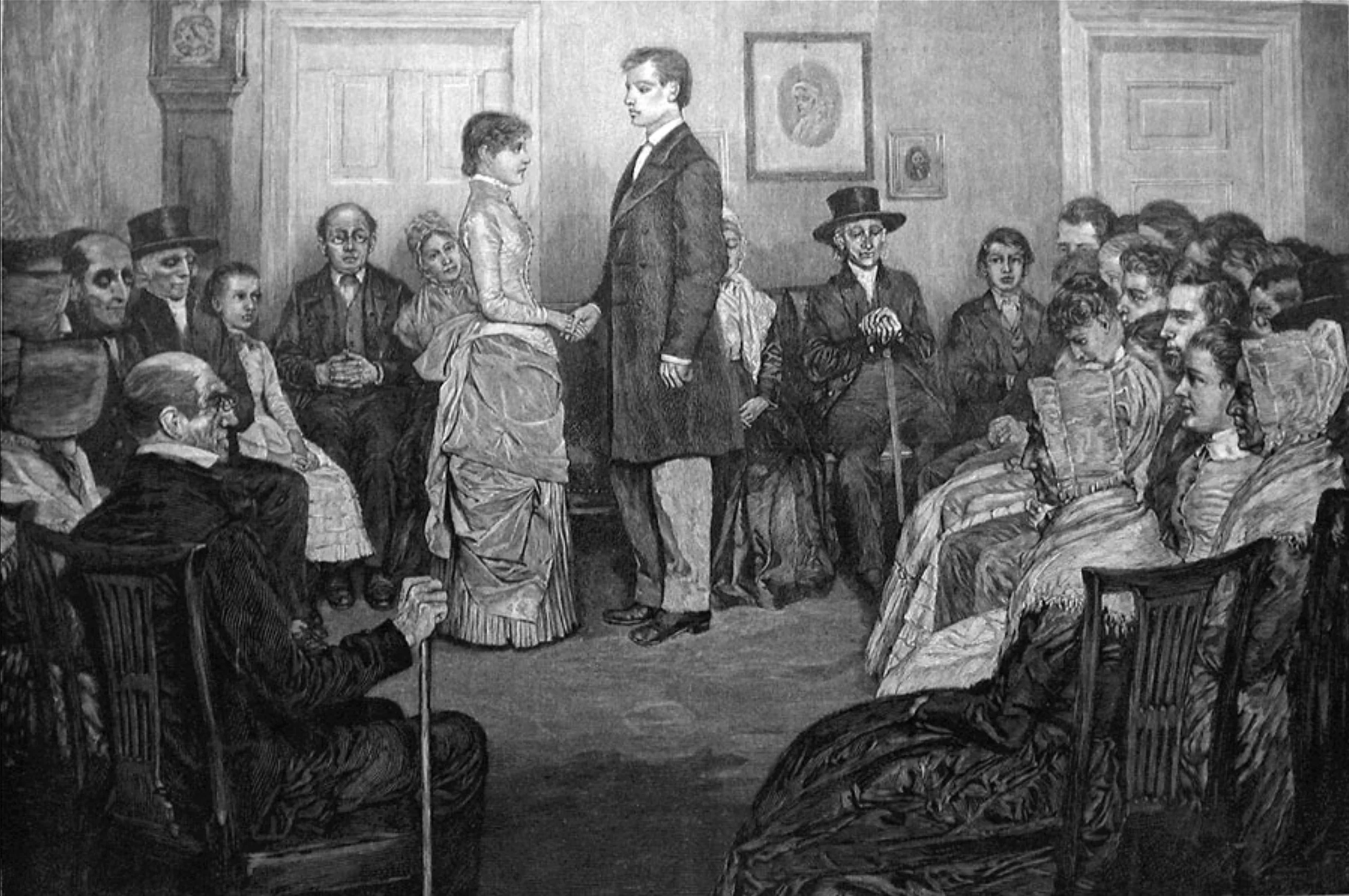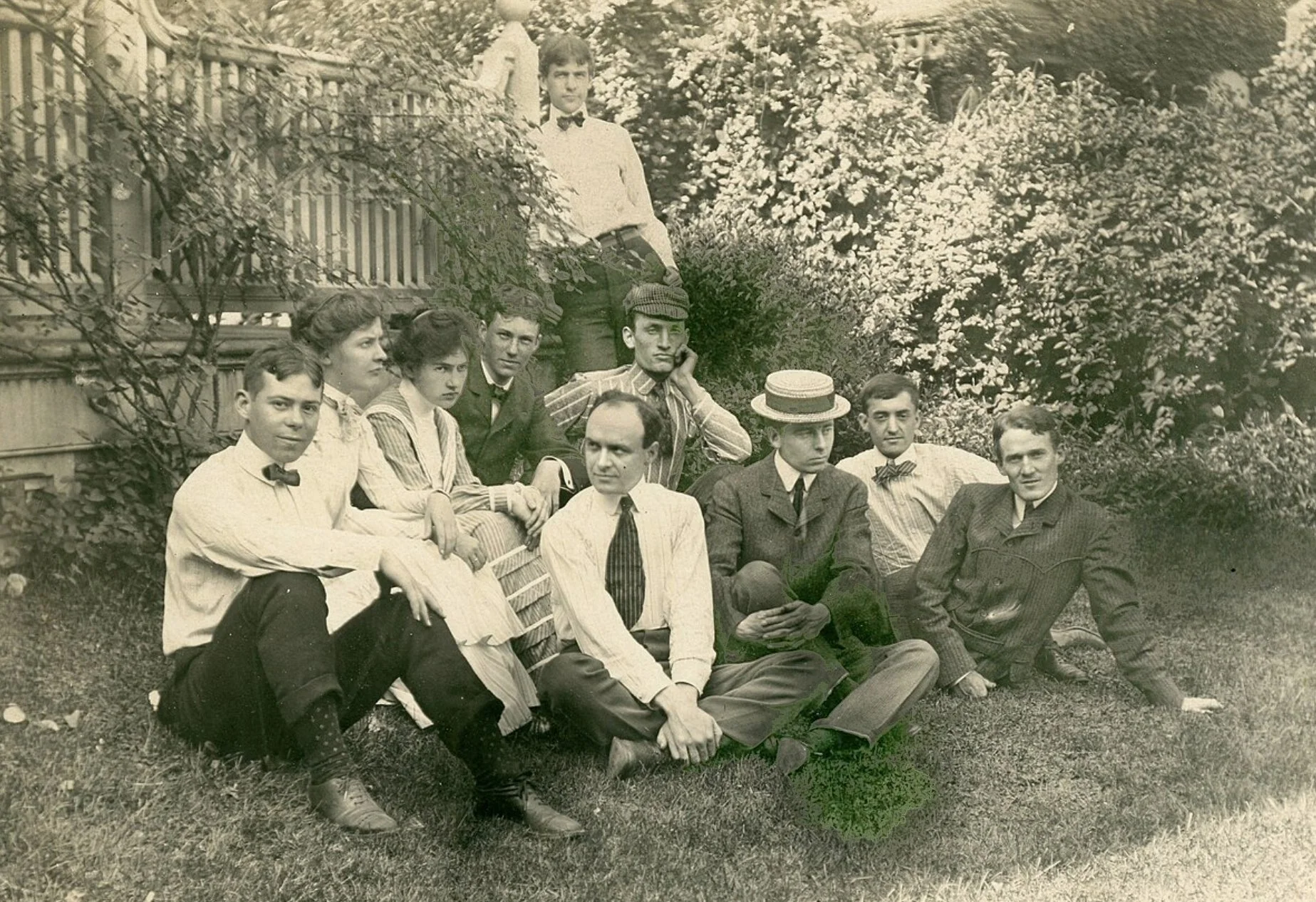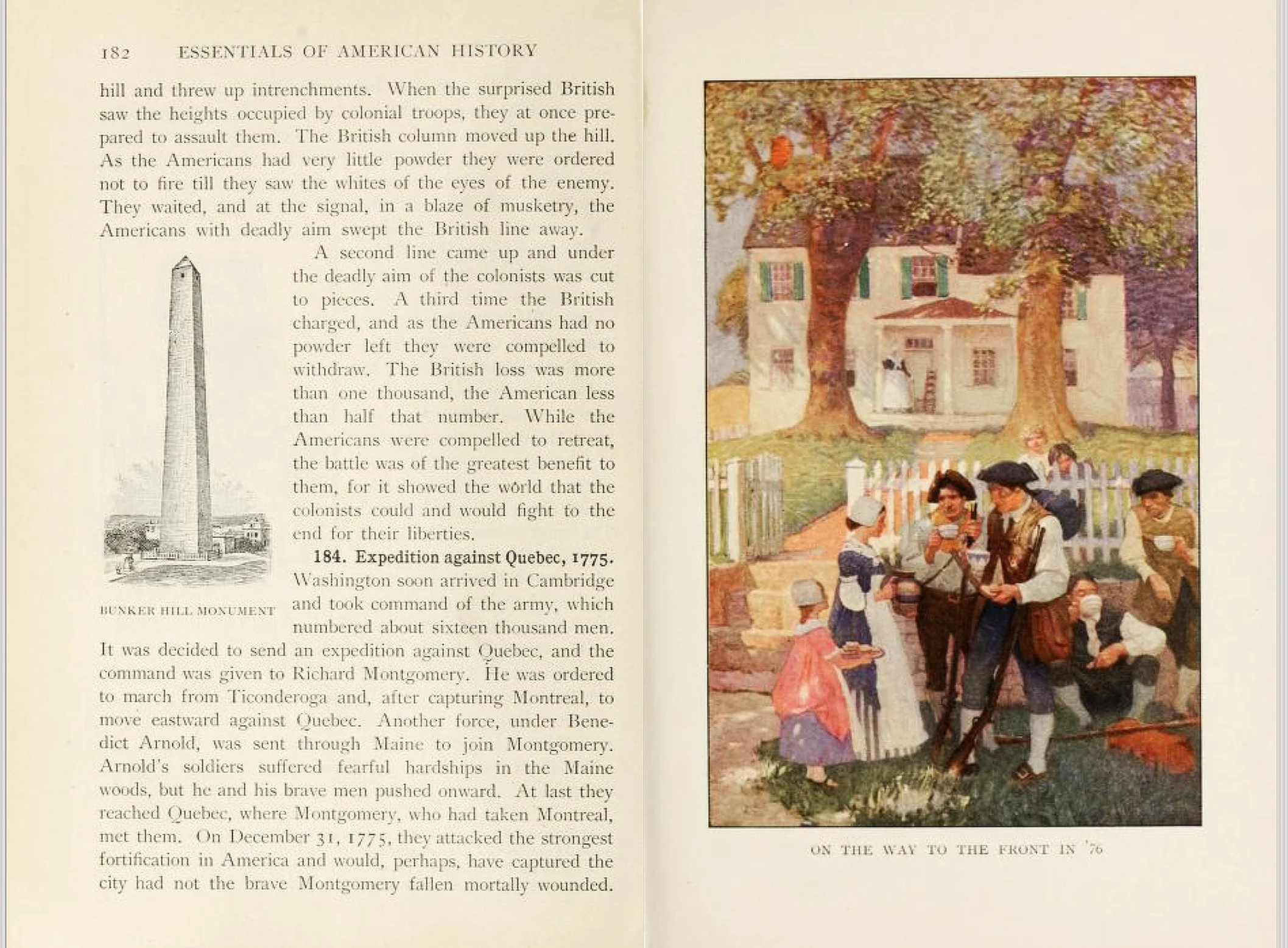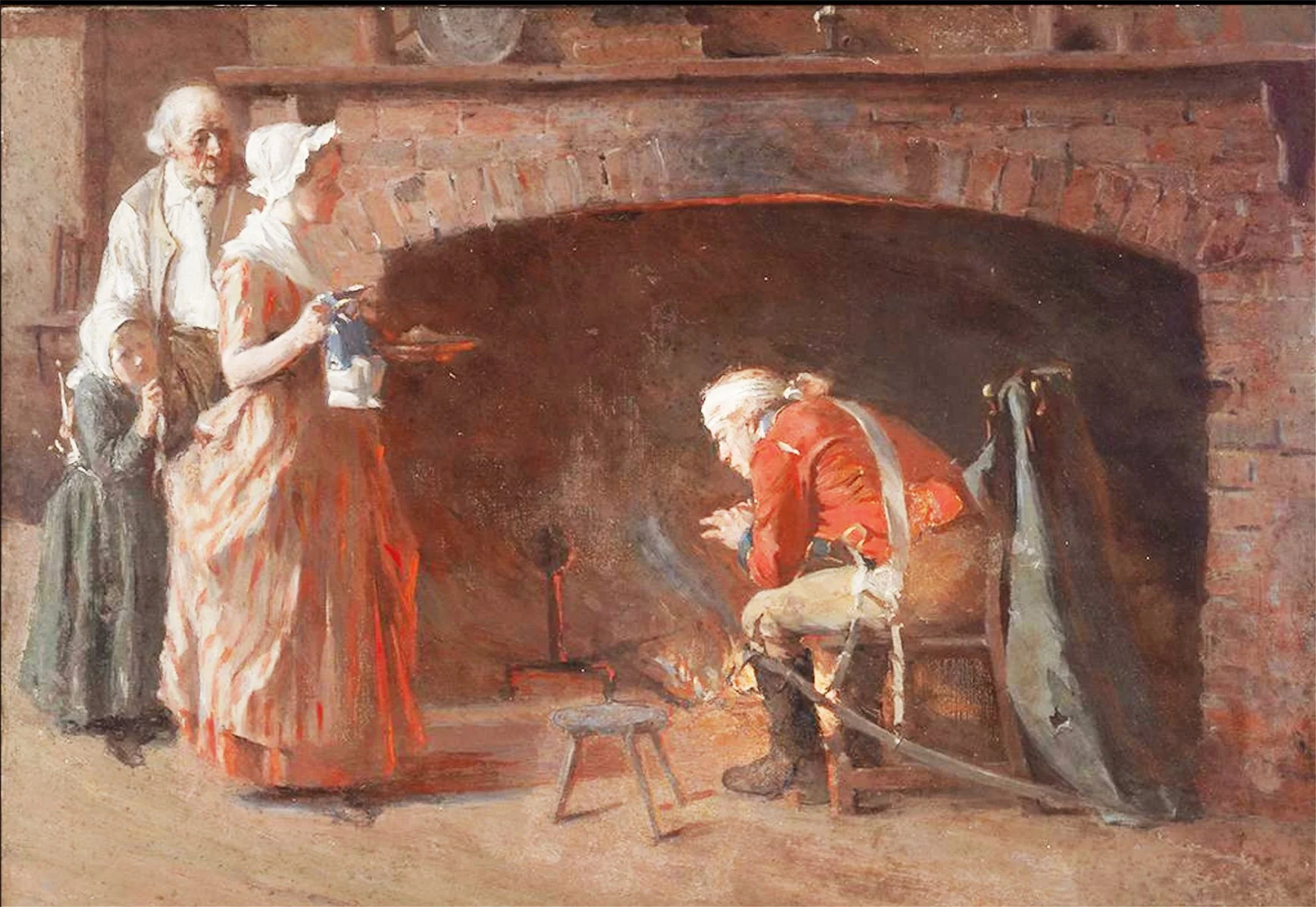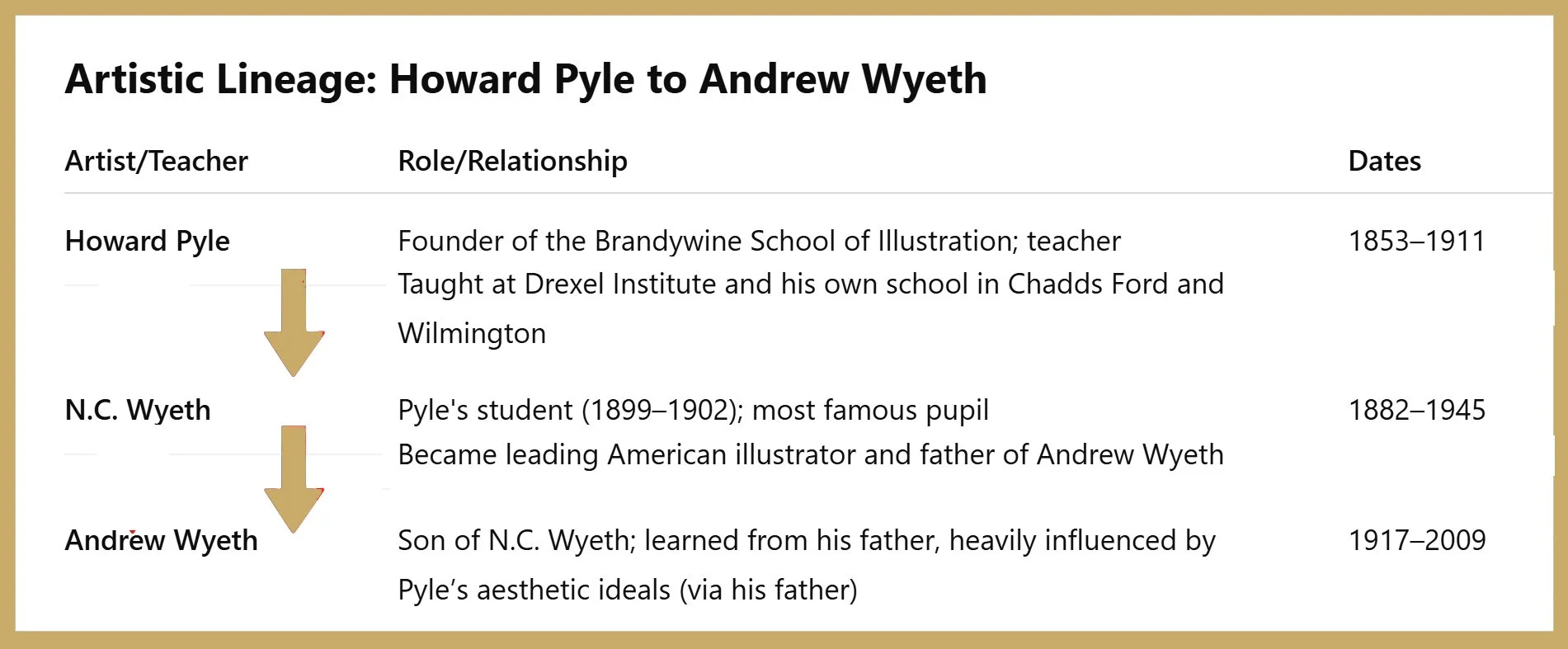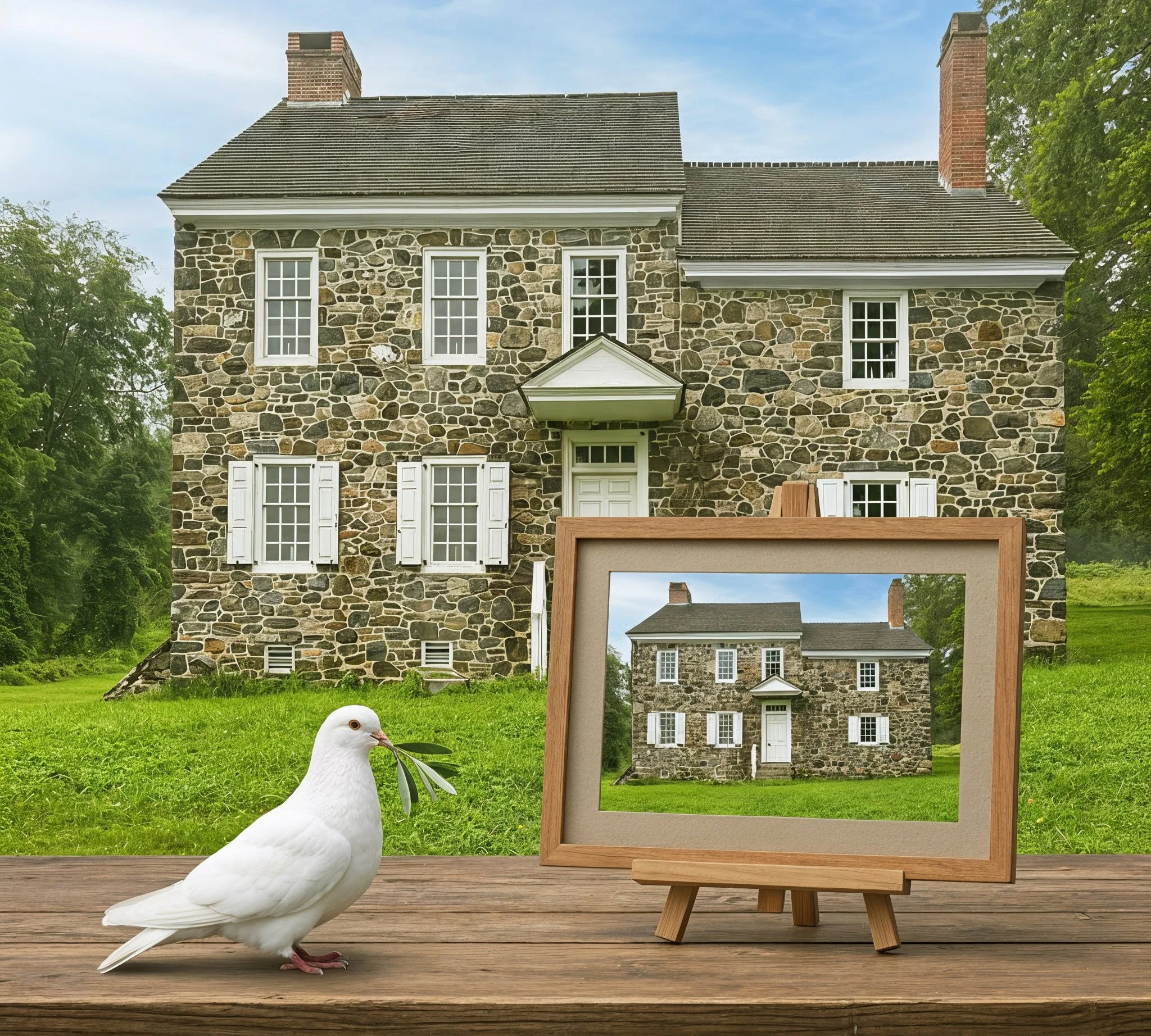Historic Quaker Houses of Delaware County, PA
Two Quaker Farmhouses
On the Brandywine Battlefield
Used for Howard Pyle’s Art School
Including George Washington’s Headquarters:
Above: Two historic Quaker houses on the grounds of Brandywine Battlefield Park. Images source: Lee J. Stoltzfus
Ring House (Benjamin and Rachel Ring House) / General George Washington’s Headquarters:
The Ring House was built in 1731. During the Brandywine Battle it was the home of Benjamin Ring and wife Rachel (James) Ring, both members of the local Quaker meeting. As Quakers, they attempted to uphold the testimonies of peace and neutrality. Despite this, the house became General George Washington’s headquarters before the Battle of Brandywine in 1777, placing the Ring family at the heart of a conflict they sought to avoid.
The house burned down into a pile of rubble in 1931. The house was rebuilt to its Revolutionary War appearance by Architect G. Edwin Brumbaugh in 1952.
Above: Rear view of the Gilpin House (the girls’ residence for Howard Pyle’s art school) with rear kitchen wing and bake oven. Image source: Lee J. Stoltzfus
Gilpin House (Gideon and Sarah Gilpin House)
The Gilpin House, also located on the Brandywine Battlefield, was the home of prominent Quaker farmers Gideon Gilpin and wife Sarah (Gregg) Gilpin. The stone portion of the house was built by Gideon Gilpin’s father, Joseph Gilpin, in 1745. Gideon purchased this tract from his father in 1764. The rear kitchen was added in 1782.
Gideon Gilpin was a member of Concord Monthly Meeting. He tried to uphold the Quaker’s testimony of peace during the Revolutionary War. He remained committed to neutrality during the Battle of Brandywine.
After the battle, British troops looted Gideon Gilpin’s farm, leaving him nearly destitute. In 1778, he pledged loyalty to the Pennsylvania government and supported the local militia. These actions led to his disownment by his Quaker meeting. He later was reinstated to the meeting after expressing remorse.
Both Houses were used for Howard Pyle’s Art School
Quaker / Swedenborgian Artist Howard Pyle -
The Father of American Illustration:
Above: Quaker / Swedenborgian artist Howard Pyle and his painting The Evacuation of Charleston by the British, December 14, 1782, painted in 1892 to illustrate “The Story of the Revolution," by Henry Cabot Lodge, in Scribner's Magazine. Image sources: Portrait: Delaware Historical Society, Painting: Delaware Art Museum
Oil Paintings by Howard Pyle:
Above: An Attack on a Galleon by Howard Pyle (1905) Image source: Delaware Art Museum
Above: The Buccaneer by Howard Pyle (1905) Image source: Delaware Art Museum
Above: The Mermaid by Howard Pyle. (1910) Image source: Delaware Art Museum
Pyle’s Pirates
Not Your Usual Quaker Characters:
“Pyle tacitly acknowledging the anomaly of pirates in in pantheon of heroic types, wrote that they ‘are hardly of the pacific nature one would expect of a boy with two hundred years of pure Quaker blood in his veins, but I have always had a strong liking for pirates and for highwaymen, for gunpowder smoke and for good hard blows.’”
Above quote: Howard Pyle, American Master Rediscovered, edited by Heather Campbell Coyle, 2011, Howard Pyle to Edith Robinson, Howard Pyle Manuscript Collection, Delaware Art Museum
Above: Illustrations by Howard Pyle in his 1908 book The Ruby of Kishmoor. Pyle authored this adventure story and created the illustrations. Images source: Internet Archive
Robin Hood (1883) and King Arthur (1903)
Written and Illustrated by Howard Pyle:
Above: The Merry Adventures of Robin Hood… (1883, first edition), written and illustrated by Howard Pyle. Image source: Internet Archive
Above: The Story of King Arthur… (1903, first edition), written and illustrated by Howard Pyle. Image source: Internet Archive
Artist Howard Pyle - A Birthright Quaker
How Quaker was Howard Pyle?
Howard Pyle was a pioneering American illustrator, author, and teacher. He is often named the “Father of American illustration.” Born in Wilmington, Delaware, he was raised a family with deep Quaker roots, though he did not remain an active member of the Society of Friends as an adult. Pyle gained national recognition for his vivid illustrations and retellings of classic legends like Robin Hood and King Arthur. Through his teaching he trained a generation of artists who became leaders in American illustration, including N.C. Wyeth, Jessie Willcox Smith, and Maxfield Parrish.
Pyle’s first American ancestor on his father’s side was Robert Pyle who came to America in 1682 with William Penn’s company. When Pyle was about seven years old his Quaker parents began attending the Swedenborgian church and were read out of Quaker meeting. Howard Pyle attended Swedenborgian church regularly, although he got married in the Quaker tradition in the home of his wife Anne Poole. He used the Quaker thee in writing to his wife. When writing to friend A. B. Frost he referred to “my Quaker family.”
“It was not a matter of abandoning one [Quakerism] for the other [Pyle’s Swedenborgian beliefs] - he would encompass both although he was no longer a recognized member of the Society of Friends.” Howard Pyle, by Henry C. Pitz, 1965.
“Yet the Quaker simplicity, handed down from generation to generation, remained undiminished under Swedenborgian
influences. He retained throughout his life a simplicity of character that was most unusual for one of his versatile genius, and which was probably due to the long tradition of Quakerism which lay behind him.” Howard Pyle, A Chronicle, by Charles D. Abbott, 1925.
A Quaker Wedding
Illustration by Howard Pyle in 1885:
Above: A Quaker Wedding illustration by Howard Pyle in 1885, published in Harper’s Bazar, Dec. 12, 1885. Image source: howardpyle.blogspot.com/ Ian Schoenherr.
Howard Pyle married a Quaker woman named Anne Poole in 1881, four years before the publication of this Quaker wedding illustration. The Pyle’s Quaker wedding ceremony took place at the home of Anne’s parents in Wilmington, Delaware. This was fairly typical at the time, especially among families of similar social and religious backgrounds. Anne Poole came from a well-known Wilmington family, and the ceremony was private and relatively modest.
Portrait of Quaker Martyr Mary Dyer
By Howard Pyle
She was Hanged by Puritans in Boston
Because of Her Quaker Faith:
Above: Oil painting by Howard Pyle (1905) of Quaker martyr Mary Dyer on her way to her execution. Boston Puritans hanged her for her Quaker beliefs in 1660. Image source: Newport Historical Society.
Howard Pyle’s Students
The Howard Pyle School of Art:
Above: Howard Pyle’s students painting en plain air at Chadds Ford in 1899. Image source: Delaware Art Museum
Above: Howard Pyle’s students at his studio in Wilmington, Delaware. Image source: Delaware Art Museum
Howard Pyle founded a summer art school at Chadds Ford. He brought a select group of his most promising students from Wilmington to the Brandywine Valley, where they lived and worked together in a setting rich with American history. The program emphasized storytelling, dramatic composition, and historical authenticity, values that became central to what would later be called the Brandywine School. Among Pyle’s most notable students were N.C. Wyeth, Jessie Willcox Smith, Maxfield Parrish, and Frank Schoonover, all of whom went on to become leading American illustrators in the early 20th century.
Illustration of the Ring House / Washington’s Headquarters
A Boys’ Residence at Howard Pyle’s Art School
Above: N. C. Wyeth’s illustration On the Way to the Front in ‘76 appears in the 1918 history textbook Essentials of American History by Thomas Lawler. The painting depicts Continental soldiers heading toward the frontline. The Ring house / Washington’s Headquarters is in the background. The artist N. C. Wyeth was the most famous student of the Howard Pyle Art School. This Ring house was a boys’ residence for that summer school.
Love Your Enemies
Anti-War Traditions in the Brandywine Valley
Quaker Convictions During the Revolutionary War:
Above: The Enemy at the Door (detail) by Howard Pyle (1895)
from “Some Thanksgiving-Time Fancies”
Scribner's Magazine, November 1895 Image source: Art and Artists
Above: Love Your Enemies (detail) by Violet Oakley ( ca.1897), oil on canvas. Violet Oakley was a student of Howard Pyle. She apparently painted this work for Howard Pyle’s advanced illustration class. Pyle often gave students themes that echoed subjects from his own work. Image source: Brandywine Museum of Art.
The Brandywine Valley was an important center of Quaker life in the 18th century. Strong beliefs in nonviolence and neutrality shaped the community’s response to the Revolutionary War. Most Quakers were guided by their peace testimony and refused to take up arms or support either side. They maintained a pacifist stance despite pressure and suspicion from both British and American forces. Their commitment to peace left a lasting mark on the area's history and identity.
A Painting of the Gilpin House
By Andrew Wyeth in 1941:
Above: Pennsylvania Landscape by Andrew Wyeth, 1941. Tempera on panel. Image source: Brandywine Museum of Art.
The Gideon Gilpin House was long believed to have served as General Lafayette’s headquarters during the Battle of Brandywine. However, more recent historical research has shown that Lafayette did not use this house as his headquarters. While he was wounded nearby, there is no evidence he stayed or commanded from the Gilpin home.
This painting was one of eight by Andrew Wyeth selected for the Museum of Modern Art’s influential 1943 exhibition Americans 1943: Realists and Magic Realists. The show marked a turning point in his early career, earning him national recognition and critical acclaim as it toured New York and nine other cities across the U.S. and Canada.
Above: A digital Quaker dove of peace at the Ring House / George Washington’s headquarters on the Brandywine Battlefield. Image source: Lee J. Stoltzfus / Leonardo.AI
Links:


